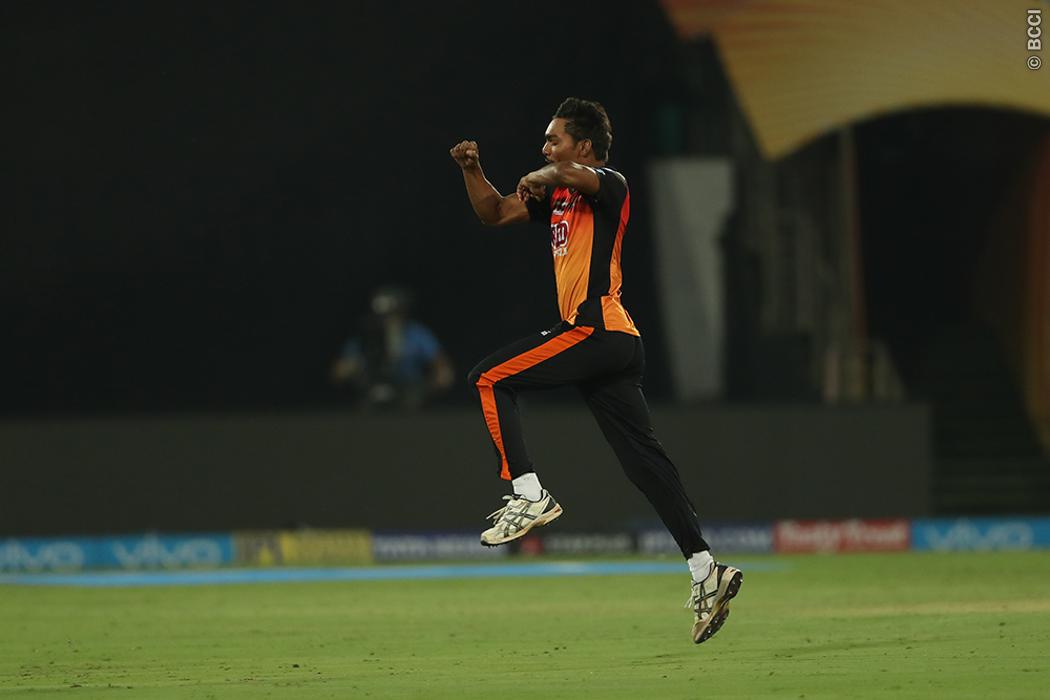How Mr.Consistent Sandeep Sharma’s numbers prove he’s amongst the elites in IPL history
'I fear not the man who has practised 10,000 kicks once, but I fear the man who has practised one kick 10,000 times.' Perhaps Bruce Lee was a Time Lord, and all he was referring to, in this quote, was the art of outswing and how Sandeep Sharma had mastered it.

A lot has happened since May 11, 2013. In the world, in general, but more so in the IPL. Mumbai Indians have taken their IPL Trophy tally from 0 to 4; David Warner has transformed from just another Australian brat to the greatest and most prolific batsman to have graced the competition; The city of Pune has had two franchises finish in the bottom half and go defunct; Aaron Finch has switched five franchises. More recently, three days ago, Sandeep Sharma went from ‘the kid who would get found out with time’ to just the sixth Indian pacer to claim 100 wickets in the IPL.
May 11, 2013 is of course the day when a 19-year-old Sandeep made his debut in the IPL. Then, representing Kings XI Punjab, he ran through the Sunrisers Hyderabad middle-order on a seam-friendly Mohali wicket through a solitary weapon: the inswinger. Ater rather luckily seeing the back of Hanuma Vihari through a rank wide one outside off-stump, Sandeep then trapped Cameron White plumb in front of the stumps, before going through the defences of Biplab Samantray on the very next ball.
It was a fine debut, but it wouldn’t be until almost a year later, against Royal Challengers Bangalore, that his career, and subsequently his name, would take flight. Up against a rampant Chris Gayle, who was batting on 20*(6) in his first game of the IPL 2014 season, Sandeep, playing in just the 7th IPL match of his career, castled the big Jamaican through a booming outswinger. Gayle did not look back, hearing the stumps clatter, and well, so didn’t Sandeep’s career. From thereon, the right-armer from Punjab would go on to claim 88 IPL wickets in 82 innings, including accounting for Gayle himself three more times, and even clinch a national cap.
But despite consistently putting up numbers and adding to his tally, Sandeep’s reputation has taken a hit over the past half a decade or so. His hype has fizzled out and his name has drifted farther and farther away from the radar of the selectors. This has largely been due to his one-dimensionality which has, let’s say, rubbed the men who matter the wrong way. Despite adding the natural variation of the ball going straight to his arsenal, and despite mastering the knuckle ball, Sandeep has continued to rely on his stock delivery, the inswinger to the right-hander, something that has made him predictable. Or at least that’s the general perception.
Although knowing his game inside out, Sandeep has continued to exist as a bowler with limitations - his average speed being around the 120 kph mark has hardly helped - and so in this golden era for fast bowling in Indian cricket where the competition is cutthroat, the right-armer has invariably seen himself slip farther and farther down the pecking order.
That he would never play again for India seems a certainty, but what’s remarkable, and has completely slipped under the radar, though, is how consistent, effective and reliable he has been, through the course of the past six years. Going by numbers, in fact, there is a case to be made that Sandeep is right up there amongst the best pacers to ever play in the IPL.
On Saturday versus Punjab, his old franchise, Sandeep attained the coveted milestone of 100 IPL wickets. But unlike several other bowlers, he did not ‘just get to the landmark’ by racking up matches. Among the 15 bowlers in IPL history to have taken 100 or more wickets in the competition, Lasith Malinga, Yuzvendra Chahal and Ashish Nehra are the only bowlers to have had a better wickets-per-game ratio than Sandeep. These are figures significantly better than Dwayne Bravo, Sunil Narine, Ravi Ashwin and even Jasprit Bumrah (99 wickets) all of whom are considered the greatest to grace the competition.
But what makes Sandeep stand out is not just his wicket-taking ability, but also his control; his tendency to keep a lid on the scoring. Far too often, pacers who tend to be prolific leak runs aplenty in search of wickets, but that is not the case with Sandeep. Among pacers to have taken 100 or more wickets in the IPL, the 27-year-old’s ER of 7.79 is the fourth-best, and amongst the ones above him, only Malinga has a superior wickets-per-innings ratio.
It is this consistency that has been a facet of Sandeep’s success in the IPL, since his debut back in 2013. For someone of his pace and stature, and for someone who heavily relies on one weapon, sustainability in a world-class competition like the IPL can be a nightmare, due to the threat of being found out, but Sandeep, season after season, has showcased his mettle and consistency.
In each of his six full seasons in the IPL (excluding 2020 and 2013), Sandeep has returned at least 12 wickets and has, on top of that, also managed to concurrently keep the batsmen under check. Across 8 seasons in the IPL, only thrice has the right-armer leaked over 8 runs per over in a season, and has startlingly managed to maintain an ER south of 7.60 in 5 of his 8 seasons in the tournament.
So how could a bowler with such extraordinary numbers behind his name be patronized by fans and experts - to the extent that his achievements are, time and again, played down and dismissed with disdain?
A lot stems from the fact that he is largely seen as a ‘powerplay merchant’. And to be fair, there is truth to it. Sandeep has bowled an astonishing 58.5% of his IPL overs inside the powerplay, despite the phase constituting only 30% of the entire game. 47.5% of all his wickets have come inside the powerplay and this season, 4 of his 6 wickets have also been taken inside the first six.
This is largely due to the intrinsic nature of who he is as a cricketer - a classical swing bowler of the Praveen Kumar mould who thrives on air movement.
But that isn’t necessarily bad for the side if it helps get one up on the opposition, early on. CSK used this ploy effectively in each of the last two editions with Deepak Chahar, where the right-armer, someone not too different from Sandeep, bowled 3 of his 4 overs inside the first six in an attempt to dent the opponent early. As it turns out, Sandeep has been ‘Chahar-ing’ since the start of his IPL career.
2:36
In 13 seasons of IPL, only Zaheer Khan has taken more wickets in the first six overs than Sandeep Sharma, and among bowlers who have bowled 150.0 or more overs inside the first six, only Dhawal Kulkarni has a superior strike rate. While the likes of Bhuvneshwar Kumar, Steyn and Praveen Kumar have been exceptional in strangling batters up-front, their wicket-taking potency is far behind that of Sandeep.
But while Sandeep is and has always been a beast with the new ball, doubts over his credibility as a ‘complete’ T20 bowler have always emerged due to his liability with the older and softer cherry. Not someone who can hit the blockhole on a consistent basis, the 27-year-old, particularly in the initial stages of his career, was seen going the distance towards the back end of the innings where conventional bowling seldom troubles batsmen. However, there has been a stark difference in old-ball-bowling between the Sandeep Sharma of KXIP and Sandeep Sharma of SRH.
Despite only having bowled half the overs he did at KXIP, Sandeep’s numbers between overs 16 and 20 have seen a significant improvement in SRH colours.
In fact, granted the sample size is miniscule compared to the rest, since the start of the 2018 season, Sandeep has maintained an ER of 8.25 at the death, which is the third best amongst all bowlers who have at least bowled 20 overs towards the back end (overs 16-20).
Sandeep’s gradual improvement at the death, by the passing season, is no coincidence as he’s been consciously working on his variations. They were, in fact, on full display in SRH’s previous clash versus Kings XI, where, reading and understanding the slow nature of the wicket, he unleashed his knuckle-ball as early as the fifth over of the innings to outsmart Mandeep Singh.
Not too long ago, I referred to Vernon Philander as the Jack of one trade, master of one, and, congenitally, Sandeep is not too different. There is something about sportsmen who understand their limitations, yet strive as hard as they can to be the best version of themselves - Sandeep epitomizes the prototype of such a player. Where he’ll end up in the pantheon of the most prolific wicket-takers in the IPL remains to be seen, but for now, the least we can do is enjoy, acknowledge and appreciate the inevitability of his in (out) swinger, for he’s practiced it 10,000 times.

Comments
Sign up or log in to your account to leave comments and reactions
0 Comments